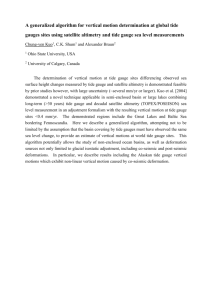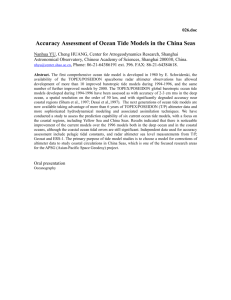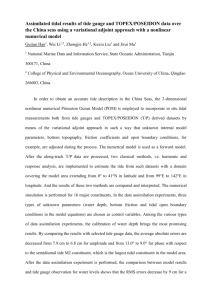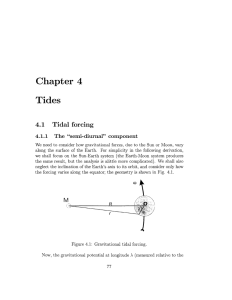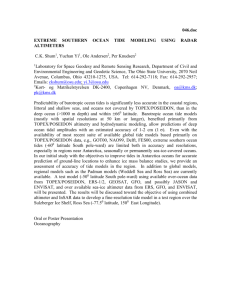Study of Sea Level Variation of Exclusive Economic Zone of... Kamaludin Omar , Shahrum Ses
advertisement
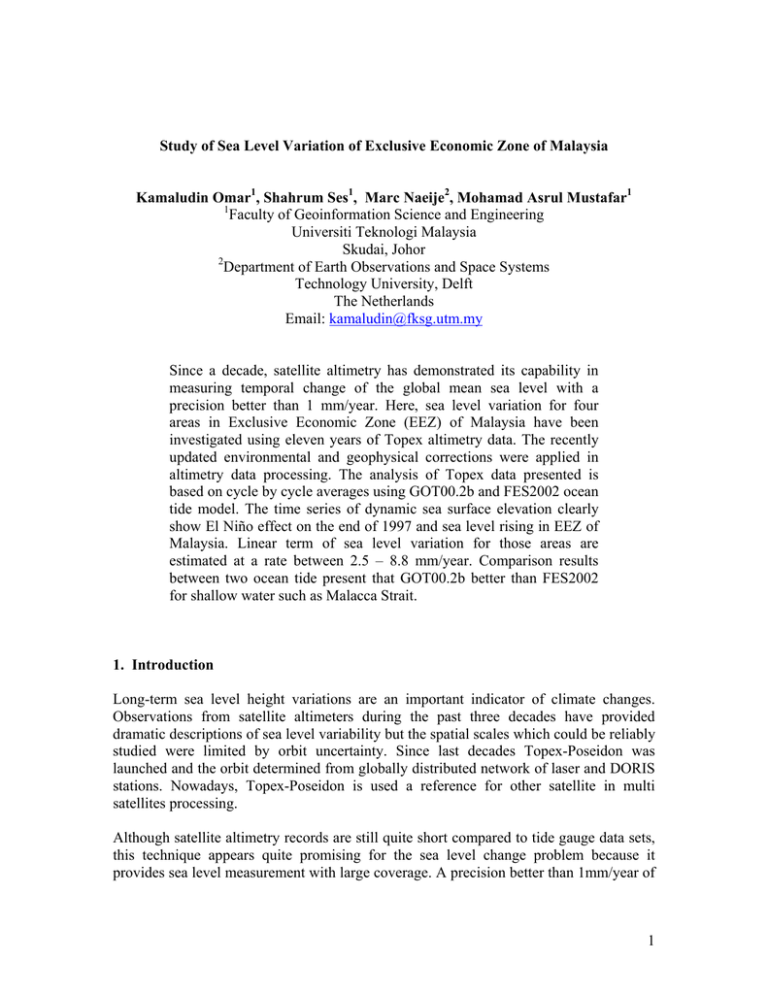
Study of Sea Level Variation of Exclusive Economic Zone of Malaysia Kamaludin Omar1, Shahrum Ses1, Marc Naeije2, Mohamad Asrul Mustafar1 1 Faculty of Geoinformation Science and Engineering Universiti Teknologi Malaysia Skudai, Johor 2 Department of Earth Observations and Space Systems Technology University, Delft The Netherlands Email: kamaludin@fksg.utm.my Since a decade, satellite altimetry has demonstrated its capability in measuring temporal change of the global mean sea level with a precision better than 1 mm/year. Here, sea level variation for four areas in Exclusive Economic Zone (EEZ) of Malaysia have been investigated using eleven years of Topex altimetry data. The recently updated environmental and geophysical corrections were applied in altimetry data processing. The analysis of Topex data presented is based on cycle by cycle averages using GOT00.2b and FES2002 ocean tide model. The time series of dynamic sea surface elevation clearly show El Niño effect on the end of 1997 and sea level rising in EEZ of Malaysia. Linear term of sea level variation for those areas are estimated at a rate between 2.5 – 8.8 mm/year. Comparison results between two ocean tide present that GOT00.2b better than FES2002 for shallow water such as Malacca Strait. 1. Introduction Long-term sea level height variations are an important indicator of climate changes. Observations from satellite altimeters during the past three decades have provided dramatic descriptions of sea level variability but the spatial scales which could be reliably studied were limited by orbit uncertainty. Since last decades Topex-Poseidon was launched and the orbit determined from globally distributed network of laser and DORIS stations. Nowadays, Topex-Poseidon is used a reference for other satellite in multi satellites processing. Although satellite altimetry records are still quite short compared to tide gauge data sets, this technique appears quite promising for the sea level change problem because it provides sea level measurement with large coverage. A precision better than 1mm/year of 1 measuring global sea level can be obtained using Topex-Poseidon. It is the one of remarkable results from satellite altimetry (Nerem et al.,1995). Cecile et al. (2001) analyses the global mean sea level rise at rate 2.5mm/year. On time scales longer than 1 year, global mean sea level change results from two main causes: (i) volume change due to seawater density change in response to temperature and salinity variations (the two parameters having opposite effects on sea level) and (ii) mass change due to exchange of water with atmosphere and continents, including glaciers and ice sheets, through precipitation, evaporation, river runoff, and ice melting. 2. Topex Data Processing The Topex-Poseidon satellite, carrying two altimeters, Topex and Poseidon, was launched in August 1992 to study the large scale ocean circulation and its temporal variations (Fu et al., 1994). The satellite has been placed on a 66° inclined orbit at 1336km altitude. The orbital repeatability (or orbital cycle, i.e., time interval for the satellite ground tracks to exactly superimpose) is 9.916 days. This corresponds to an inter-track spacing of 350 km at the equator. Altimeter range measurements are provided at 1- second interval, i.e., about 6 km along. In this study, only Topex data only are being considered. Table 1: Geophysical corrections applied to Topex data Corrections Orbit Inverse Barometer Dry Tropo & IB Wet Tropo Ionospheric Earth Tide Ocean Tide Loading Tide Geoid/MSS Pole tide Sea State Bias Model JGM-3 1013.3 mbar ECMWF ECMWF Smooth Dual-Freq. Applied GOT00.2b/FES2002 GOT00.2b/FES2002 CLS01 MSS Applied BM3/BM4 Topex data covering the time span of about 11.5 years (from January 1993 through May 2004, cycles 11-429) are used in this study. Data retrieval and analyses were carried out using Radar Altimeter Database System (RADS). Table 1 summarizes the various corrections applied to the Topex altimeter range measurements. The corrections include the ionospheric delay, dry and wet tropospheric corrections, solid Earth and ocean tides, ocean tide loading, pole tide, electromagnetic bias (EMB) and inverse barometer (IB) correction. 2 h=H–R hd = h – hg – hT – ha where, H = satellite altitude R = range measurement H = sea surface height (SSH) hg = geoid/mss height hT = ocean tide height ha = atmospheric effect hd = dynamic sea surface elevation (SSE) Figure 1: Principle of satellite altimetry The Topex orbits are based on the JGM-3 geopotential model (Tapley et al., 1996). Instantaneous sea surface heights (SSH) above the ellipsoid used as reference for the satellite altitude are generated along the satellite tracks from the difference between the radial component of the orbit and the corrected altimeter range measurement. Since we are interested in the time-variable component of SSH, e.g., the sea surface height above the geoid or mean sea surface(MSS), the static part, i.e., the height of the geoid above the reference ellipsoid has been removed from SSH data at each latitude-longitude location. For this purpose, the mean sea surface CLS01is being used as reference surface. For the purpose of mapping the geographical distribution of the sea level variations over the 11.5 years, the IB correction to individual SSH measurements is applied while the global mean pressure is fixed at 1013mb. The later correction is an instantaneous static local response of the sea level to atmospheric pressure variations, the total pressure at the ocean bottom is assumed to be constant. The standard sea level correction is expressed through the relationship: -0.9948 (P-Pref) (cm) where p is the instantaneous local surface pressure (in rob) and Pref a reference pressure. Pref is assumed constant (value of 1013.3 mb is used), Minster et al. (1995). In the following, the instantaneous sea surface heights is referenced to the CLS01 mean sea surface after removal of atmospheric effect and ocean tide. This is called sea surface elevation (SSE). Four study areas within Malaysian EEZ were selected as shown in Figure 2; South China Sea, Sulu Sea, Malacca Strait and Celebes Sea. Global Ocean Tide (GOT00.2b) and Finite Element Solution (FES2002) tide models were used in the data reduction. The mean sea level time series was derived by averaging the altimeter data for every orbital cycle i.e. 10 days. 3 Tide Gauge Station Figure 2: Study areas 3. The Malaysian EEZ Mea sea level Variation: Some Initial Results For both South China Sea and Malacca Strait, the mean Sea Level rise is clearly seen from altimeter data. The short term periodic circulation of mean sea level is being revealed at open South China Sea using both tide models. On the other side, the tide models do not seem to fit very well for the shallow Malacca Street where the short term ocean circulation seems to be rather noisy. This is due to the fact that Malacca Strait is narrow and shallow water area. The GOT00.2b tide model appears to fit slightly better then FES2002 for this area. Malacca Stait - GOT00.2 South China Sea - GOT00.2 40 40 Estimated Sea Level Rise 6.2 mm/year 30 20 SSE (cm) SSE (cm) 10 0 10 0 -10 -10 -20 -20 -30 1993 Estimated Sea Level Rise 2.9 mm/year 30 20 1994 1995 1996 1997 1998 1999 2000 2001 2002 2003 -30 1993 2004 1994 1995 1996 1997 1998 2001 2002 2003 2004 40 Estimated Sea Level Rise 6.2 mm/year 30 Estimated Sea Level Rise 2.5 mm /year 30 20 20 SSE (cm) SSE (cm) 2000 Malacca Strait - FES02 South China Sea - FES02 40 10 0 10 0 -10 -10 -20 -20 -30 1993 1999 Year Year 1994 1995 1996 1997 1998 1999 Year 2000 2001 2002 2003 2004 -30 1993 1994 1995 1996 1997 1998 1999 2000 2001 2002 2003 2004 Year Figure 3: Time series of South China Sea (left) and Malacca Strait (right) using GOT00.2b (top) and FES2002 (bottom) 4 Figure 3 summarizes results of Mean Sea Level variation computations for the Malacca Strait and South China Sea. Using the straight line fitting, the sea level rise for South China Sea and Malacca Strait are estimated at 6.2mm/year and 2.5-2.9mm/year respectively. Mean Sea Level variations for Sulu Sea and Celebes Sea are shown in Figure 4. Both areas have shown similar pattern of sea level variations, and both tide models seem to fit well to these areas. The rate of mean sea level rise are estimated at 6.9-7.0mm/year and 8.1-8.8mm/year respectively. The effect of EL-Nino on sea level is clearly seen where the sea level begins to fall in 1997 and back to the normal in the middle of 1998. Figure 5 shows the 2nd and 5th order polynomial fitting for the areas to model the long term variations. The two neighboring seas seem to have interesting common pattern of sea level fall in 2000. Celebes Sea - GOT00.2 Sulu Sea - GOT00.2 40 40 Estimated Sea Level Rise 7.0 mm/year 30 20 20 SSE (cm) SSE (cm) Estimated Sea Level Rise 8.8 mm/year 30 10 0 10 0 -10 -10 -20 -20 -30 1993 1994 1995 1996 1997 1998 1999 2000 2001 2002 2003 -30 1993 2004 1994 1995 1996 1997 1998 Sulu Sea - FES02 2001 2002 2003 2004 Celebes Sea - FES02 Estimated Sea Level Rise 6.9 mm/year 30 Estimated Sea Level Rise 8.1 mm/year 30 20 SSE (cm) 20 SSE (cm) 2000 40 40 10 0 10 0 -10 -10 -20 -20 -30 1993 1999 Year Year 1994 1995 1996 1997 1998 1999 2000 2001 2002 2003 -30 1993 2004 1994 1995 1996 1997 1998 Year 1999 2000 2001 2002 2003 2004 Year Figure 4: Time series of Sulu Sea (left) and Celebes Sea (right) using GOT00.2b (top) and FES2002 (bottom) Sulu Sea - 5th Order Polynomial 40 30 30 20 20 SSE (cm) SSE (cm) Sulu Sea - 2nd Order Polynomial 40 10 0 10 0 -10 -10 -20 -20 -30 1993 1994 1995 1996 1997 1998 1999 2000 2001 2002 2003 2004 -30 1993 1994 1995 1996 1997 1998 Celebes Sea - 2nd Order Polynomial 2001 2002 2003 2001 2002 2003 2004 40 30 30 20 20 SSE (cm) SSE (cm) 2000 Celebes Sea - 5th Order Polynomial 40 10 0 10 0 -10 -10 -20 -20 -30 1993 1999 Year Year 1994 1995 1996 1997 1998 1999 Year 2000 2001 2002 2003 2004 -30 1993 1994 1995 1996 1997 1998 1999 2000 2004 Year Figure 5: The long term Mean Sea Level Variation for Sulu and Celebes Sea 5 4. Comparison with Local MSL Data A network of 21 continuously operating tide gauge stations have been established since 1984 along the coastal areas of Malaysia. The main objective of the establishment of the network is to enable a continuous time series of sea level heights be obtained for the purpose of establishing a vertical datum for the nation. The available tidal records are shown in Table 2 and their MSL values is given in Figure 6. Table 2: Computed yearly height of mean sea level (in metres) Tide Gauge Station Year 1984 WEST COAST EAST COAST Lumut Port Kelang Tanj. Keling Kukup Johor Bahru Tanj. Sedili Tanj. Gelang Cendering Geting − 3.678 − − 2.852 − − − − 1985 1986 1987 1988 1989 1990 1991 1992 1993 1994 1995 1996 1997 1998 1999 2000 2.206 2.163 2.145 2.216 2.201 2.170 2.158 2.186 2.184 2.140 2.218 2.223 2.122 2.206 2.245 2.249 3.651 3.609 3.579 3.654 3.635 3.611 3.583 3.615 3.625 3.578 3.657 3.669 3.540 3.654 3.694 3.711 2.868 2.838 2.810 2.872 2.855 2.833 2.802 2.850 2.847 2.809 2.871 2.870 2.763 2.864 2.898 2.899 − 3.987 3.962 4.015 4.009 3.983 3.994 3.996 3.983 3.956 4.021 4.018 3.931 4.006 4.048 4.050 2.828 2.832 2.820 2.856 2.860 2.823 2.834 2.831 2.833 2.847 2.877 2.854 2.824 2.849 2.888 2.884 − − 2.373 2.406 2.405 2.419 2.393 2.385 2.384 2.388 2.407 2.421 2.381 2.404 2.440 2.436 − − 2.767 2.805 2.796 2.776 2.786 2.775 2.776 2.773 2.813 2.802 2.782 2.803 2.840 2.833 2.187 2.183 2.175 2.213 2.209 2.182 2.196 2.175 2.187 2.183 2.222 2.194 2.188 2.207 2.243 2.240 − − 2.252 2.305 2.294 2.267 2.290 2.253 2.297 2.286 2.309 2.323 2.298 2.284 2.327 2.271 Mean 2.189 3.632 2.847 3.997 2.847 2.403 2.795 2.199 2.290 6 4 3.5 Kukup Port Kelang Height (m) Tg. Keling Johor Bahru P. Tioman 3 Tg. Gelang P. Pinang Tg. Sedili P. Langkawi Getting 2.5 Lumut Cendering 2 1984 1988 1992 1996 2000 Year Figure 6: Yearly mean sea levels for all tide gauge stations in Peninsular Malaysia The trend rates are given in Table 3 and represented graphically in Figure 7. It shows that a trend in sea level around Peninsular Malaysia exists and varies quite significantly from one location to another. It can also be seen that the linear trends of the MSL variations are positive, indicating an overall rise in the sea level around the coast of Peninsular Malaysia. The rising trend ranges from 1.7 ± 6.0 mm/year at Tanjung Keling on the west coast to 3.4 ± 0.2 mm/year at Tanjung Gelang on the east coast. Taking the average of the group, the indication is that relative sea level trends in Peninsular Malaysia show 2.4 ± 0.5 mm/year. 7 Table 3: Sea Level Rise for Peninsular Malaysia From Tide Gauges Tide Gauge Station West Coast Lumut 1985 to Data Used 2000 East Coast Port Tanj. Kukup Johor Kelang Keling Bahru Tanj. Sedili Tanj. Cendering Geting Gelang 1984 to 2000 1985 to 2000 1986 to 2000 1985 to 2000 1987 to 2000 1987 to 2000 1985 to 2000 1987 to 2000 Mean 2.189 3.632 2.847 3.997 2.847 2.403 2.795 2.199 2.290 Linear Trend (cm/yr) 0.28 0.18 0.17 0.26 0.22 0.25 0.34 0.26 0.21 Std. Error ± 0.04 (cm/yr) ± 0.05 ± 0.60 ± 0.03 ± 0.02 ± 0.02 ± 0.02 ± 0.62 ± 0.02 0.4 T. Gelang Linear Trend (cm/year) 0.35 Lumut 0.3 Kukup 0.25 Cendering T. Sedili J. Bahru Geting P. Kelang 0.2 T. Keling 0.15 0.1 0.05 0 0 1 2 3 4 Gauge 5 Station 6 Tide 7 8 9 10 Figure 7: Ordered plot of linear trend estimate of mean sea level The rising trend of observed MSL on the west coast ranges from 1.7mm/year (Tanjung Keling) to 2.8mm/year (Lumut). This shows some agreement with the satellite altimetric derived sea level rise of 2.5 to 2.9mm/year in the Malacca Straits. Higher rising trend of MSL from tidal measurement is observed on the east coast ranges from 2.1mm/year 8 (Getting) to 3.4mm/year (Tg. Gelang). However, satellite altimetric derived sea level rise of 6.2mm/year is being observed in the South China Sea. On the east coast, the yearly rate of sea level rise derived from satellite altimetric measurement is found to be twice as much of their corresponding value deduced from the tidal records. Since most of the tide gauges are located along the coastline of the Peninsular, direct comparison with altimetry data will obviously introduce some discrepancies particularly due to the lack of altimeter tracks close to the shore. 5. Conclusion Satellite altimetry records may still be too short to detect any long term sea level rise possibly associated with global warming and the results discussed above may hardly be comparable to those based on multi-decadal tide gauge records. However, the Topex sea level time series reveal that since 1993, the mean sea level in EEZ of Malaysia has been rising at a rate of between 2.2-8.8 mm/year. The sea level change increasing from Malacca Strait to Celebes Sea. Mean sea level using GOT00.2b shows the better results for shallow water. As longer time series become available, confidence on the results will increase. Satellite altimetry will then provide important constraints on climate models through the determination of absolute sea level changes, hence allowing an estimate of the 'true' volume and mass change of the oceans at interannual time scales. References Cecile, C., Cazenave, A., Provost, C.L., Sea Level Rise Past 40 Years Determined from Satellite and in Situ Observations. Science, 294, 840-842, 2001. Cheney, B., Miller, L., Agreen, R., Doyle, N., Lillibridge, J., Topex-Poseidon: The 2cm Solution, J. Geophys. Res., 99, 24555-24564, 1994. Fu, L.L., Cazenave A., Altimetry and Earth Science, A Handbook of Techniques and Applications, vol. 69 of International Geophysics Series. Academic Press, London, 2001. Han, G., Sea Level and Surface Current Variability in the Gulf of St Lawrence from Satellite Altimetry. Int. J. Remote Sensing, 25, 5069-5088, 2004. Milly, P. C. D., Cazanave, A., Gennero, C., Contribution of Climate-driven change in Continental water Storage to Recent Sea Level Rise. August 2003. Minster, J.F., Brossier, C., and Rogel, P., Variations of the mean sea level from Topex/Poseidon Data, J. Geophys. Res., 100, 25153-25162, 1995. Nerem, R.S., Measuring Global Mean Sea Level Variations using Topex/Poseidon Altimeter Data, J. Geophys. Res., 100, 25135-25152, 1995. 9 Tapley, B.D., Watkins, M.M., Ries, J.C., Davis, G.W., Eanes, R.J., Poole, S.R., Rim, H.J., Sdlutz, B.E., Shum, C.K., Nerem, R.S., Lerch,, F.J., Marshall, J.A., Klesko, S.M., Pavlis, N.K., and Wifliamson, R.G., The JGM-3 Gravity Model., J. Geophys. Res., 101, 2802928049, 1996. 10

